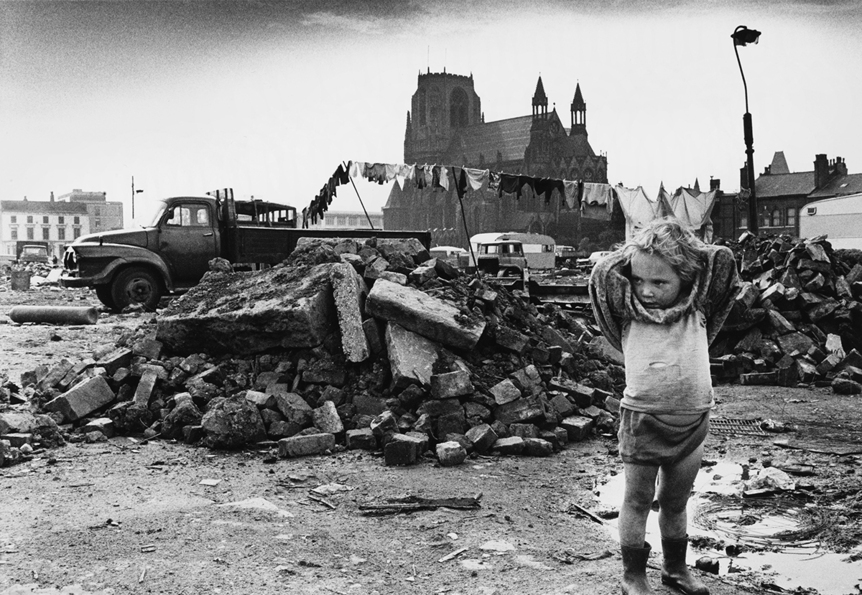
R
E
V N
E
X
T
It is a shame that in spite of the technological advances made in the area of hand-held cameras in the early to mid-20th century, it did not lead to more women taking up the art form, especially in the field of documentary photography. British photographer Shirley Baker, who passed away in September 2014 at age 82, was one of the rare female documentarians that captured street scenes of Manchester, particularly those from the city’s crumbling working class districts that were targeted for urban renewal. Currently on view at the Photographers’ Gallery in London, is the exhibition “Women, Children and Loitering Men” (7/17–9/20), which focuses on Baker’s depictions of the government-initiative clearance programs of inner-city Manchester and the city of Salford, of Greater Manchester, between 1961 and 1981.
The tightly packed terraces that became Manchester’s slums were built in the 19th century to house the workers who powered the looms and engines during the Industrial Revolution. By the end of World War II, the slum clearances—that first began in the 1930s—aggresively resumed and roughly 1.3 million homes were torn down nationwide between 1955 and 1975.
In and around the streets of Salford, Baker was documenting what she saw as the needless destruction of working-class communities. Keenly aware that she was preserving images of a vanishing world, Baker set about recording the poetry of everyday life: old ladies sitting on doorsteps in a row of condemned houses and children playing inventively among rubble and abandoned cars. She had the eye of an outsider looking inward.
Baker’s images are consistently infused with gentle humor, playfulness and affection. Influenced by French photographer Henri Cartier-Bresson (1908–2004) and American filmmaker and photographer Robert Frank (1924– ), Baker would quietly observe with her camera always ready for something to enter the frame and fill it with life. In her words, Baker once described her love for “the immediacy of unposed, spontaneous photograph,” and “the ability of the camera to capture the serious, the funny, the sublime and the ridiculous.” Further adding that while there are many “wonderful pictures of the great and famous, I feel that less formal, quotidian images can often convey more of the life and spirit of the time.”
Born in Salford on July 9 1932, Baker attended Penrhos Girls’ School in Wales, where she studied photography at Manchester College of Technology, and continued her education at Regent Street Polytechnic and the London College of Printing. She later taught photography at Salford College of Art and Manchester Polytechnic.
Baker’s work never received the recognition it deserved during her lifetime; much of it is partly attributed to her gender. At Manchester College of Technology, Baker was one of only two female students. After graduating, she attempted to gain employment at The Guardian (London), but as a woman she encountered difficulties getting a press card, so was unable to pursue photojournalism seriously. Undeterred, she took her camera to the streets and produced one of the most important photographic documents in post-war Britain. This first major exhibition of her work at the Photographers’ Gallery, compiling over 20 years of her oeuvre will finally address her neglected place in the cannon of documentary photography.
Billy Kung is photo editor at ArtAsiaPacific.



